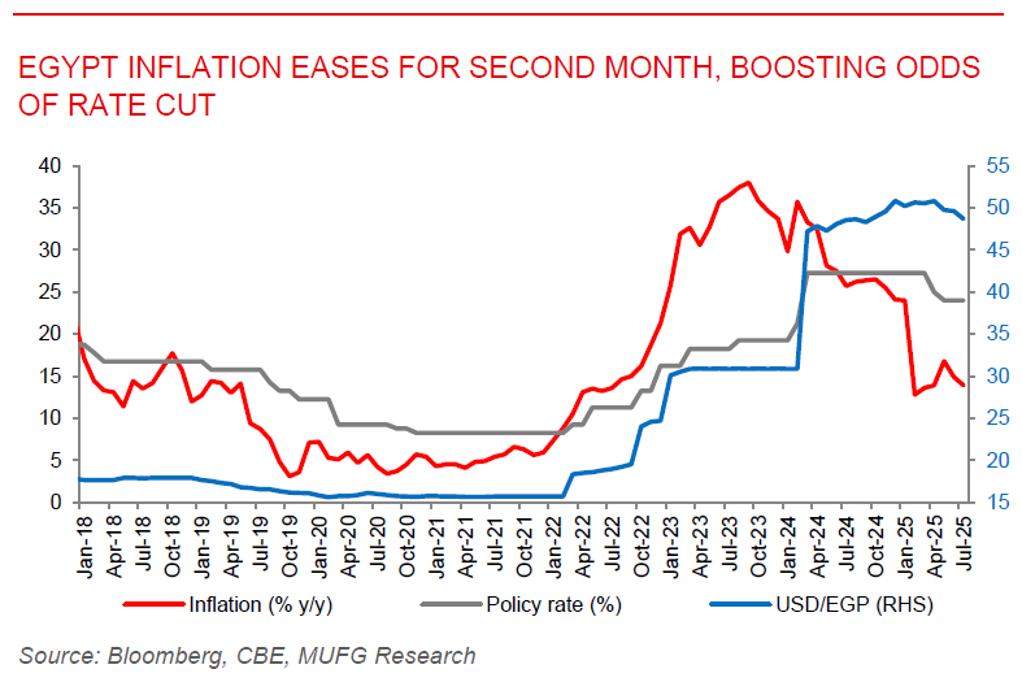To read the full report, please download the PDF above.
Middle East Daily
SOOJIN KIM
Research Analyst
DIFC Branch – Dubai
T: +44(4)387 5031
E: soojin.kim@ae.mufg.jp
MUFG Bank, Ltd. and MUFG Securities plc
A member of MUFG, a global financial group
Middle East Daily
COMMODITIES / ENERGY
Oil slips as US-Russia peace talks raise prospect of increased supply. Oil prices eased after their sharpest weekly drop since late June, with Brent hovering near USD66/b and WTI above USD63/b, as markets focused on a planned Friday meeting between US and Russian leaders that could pave the way for a Ukraine peace deal and increased Russian crude supply. Last week’s 4.4% slide came as President Trump refrained from announcing new sanctions on Russia or tariffs on buyers of its energy, despite an August 8 ceasefire deadline. Oil has fallen over 10% this year as OPEC+ restores production faster than planned and slowing global growth clouds demand prospects. A peace deal could end sanctions on Russian oil, heightening the risk of a supply glut later in 2025. Markets now await key reports from OPEC, the US Energy Information Administration, and the International Energy Agency this week for further supply-demand insights, while geopolitical tensions persist after Ukraine struck a major Russian refinery over the weekend.
Gold slips as tariff uncertainty and Fed outlook keep markets on edge. Gold prices in the US fell as traders awaited clarification on its tariff policy after a surprise US ruling last week said 100oz and 1kg gold bars would face levies. The decision briefly drove the US-London price gap above USD100 before easing to under USD60 after officials signalled “misinformation” and promised further details. The ruling, which contradicts an earlier exemption in April, could disrupt global gold flows and the US future market. Gold has gained about 30% this year on geopolitical and trade tensions. Markets now await Tuesday’s US inflation data for clues on the Fed’s next rate move, as lower rates typically boost non-yielding assets like gold.
MIDDLE EAST - CREDIT TRADING
End of day comment – 07 August 2025. As with yesterday, spreads had little impact as cash prices held firm across the MENAT complex, supported by a slight weakening in US rates. Removing filters on the pricer showed a uniform 3–6bps tightening across nearly all bonds, except for the very short-dated ones marked on T+. The largest print on TRAX was $17mm in KSA 2054s, followed by $10mm in ARAMCO 2055s, with no other trades in the space exceeding $10mm. Flows appeared aimed at keeping portfolio weights steady, with trading lists spread across curves and sectors in smaller sizes, and, as yesterday, there was little sign of eager sellers. Overall market momentum remains very low, but the buying bias is persistent, with typical two-way inquiries in most bonds likely to be shaded higher.
MIDDLE EAST - MACRO / MARKETS
Egypt inflation eases for second month, boosting odds of rate cut. Egypt’s urban inflation slowed for the second consecutive month in July, easing to 13.9% y/y from 14.9% y/y in June, while monthly prices fell 0.5%, helped by a moderation in food prices growth to 3.4% from 6.9% the month before. The slowdown follows last year’s record high of 38% in September 2023 and comes as the country continues to stabilise its economy after securing a USD57bn UAE and IMF bailout. The inflationary cooling could give the Central Bank of Egypt (CBE) scope to resume monetary easing at its August 28 policy meeting, after pausing in July following two earlier cuts. However, underlying price pressures remain, with core inflation, which excludes volatile items like fresh vegetables and fuel, inching up to 11.6% from 11.4%, reflecting persistent demand-driven and structural costs. The Egyptian pound’s recent strengthening to ~48.5 per USD on offshore markets may further ease imported inflation in the import-dependent economy. The CBE expects annual inflation to remain steady for the rest of 2025 before gradually declining through 2026, depending on non-food price trends, global conditions and domestic fiscal measures.
Saudi Arabia sets ambitious 5% unemployment target as labour market transformation accelerates. Saudi Arabia has revised its Vision 2030 unemployment target to 5% by the end of the decade, after achieving the previous 7% goal six years early in 2024, a record low for nationals, alongside an all-time low total unemployment rate of 2.8% in early 2025. The labour market transformation includes a 12% rise in Saudi private sector employment and a doubling of women’s workforce participation to 36% since 2018, driven by labour law reforms, and skills training. Youth and women’s unemployment rates have halved over the past four years while high-skill roles in tech, finance, and healthcare are expanding. The IMF credits progress to updated labour laws, investment in AI and technical education, private sector partnerships, and support for gig economy growth. The new target reflects a strategic shift from creating more jobs to delivering sustainable, high-quality employment aligned with economic diversification goals, underscoring growing confidence in Saudi Arabia’s ability to future-proof its workforce.

